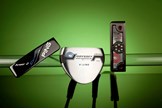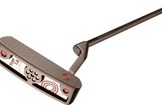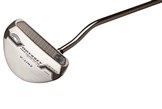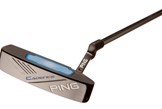Perfect putter test 2016
Published:
Toe-hang and face-balanced putters have been on the scene for years but now there’s a new putter balancing act on the scene.
The new concept is Torque Balanced, which means if you balance the putter shaft on your nger the toe of the putter – not its face – points to the sky.
The idea behind the design is that the face naturally wants to remain aimed at your target line through the stroke.
Masters sensation and now fully edged tour player Bryson DeChambeau has already bought into the concept, so we thought it was time to put the new Toe Up idea to the test, against regular toe-hang and face-balanced putters.
For this test we asked Odyssey to send us their new Toe Up #1 model along with a face- balanced V-Line Versa mallet while Ping were asked to submit a timeless mid toe- hang Anser model for comparison.
We hit putts on The Belfry’s carpetlike putting green gauging the bene ts and drawbacks of each putter from close, mid and long range.
Premium balls were used, and each tester took notes before comparing their results.
Toe up: Odyssey Toe Up #1

● Cost: £189 ● Contact: www.odysseygolf.com
THE CONCEPT
While the Toe Up concept is relatively new, Odyssey aren’t the rst putter brand to experiment with its bene ts. They are though the rst to put some serious bucks behind marketing the concept to the mainstream. Its face wants to stand up vertically, a full 90o difference to a traditional face-balanced putter. The concept is really simple; in the play position and throughout the stroke the putter wants to stay aligned to where you’ve aimed. It does this because it suffers from less of the torque which wants to open the face on a lot of face-balanced and toe-hang putters in the play position. Which in our book is seriously clever engineering.
OUR VERDICT
There’s no getting around the fact the Toe Up’s looks are a bit different to your normal putter. To achieve the correct weight balance in the head the hosel’s positioned slightly behind the face (an onset design) which Simon struggled to
love. Chris on the other hand thought it really encouraged him to get his hands ahead of the ball and focus on rocking the shoulders to swing the putter, which made for some excellent results from inside 12 feet. Both testers agreed the design felt very stable throughout the swing and particularly at the transition point between back and forward swing.
BOTTOM LINE
We reckon the Toe Up idea has got some legs, particularly if the technology can be woven into a more conventional or attractive head design. Its reduced torque design de nitely gives a different feel through the stroke, and we like how the blade model is suited to a straight back-and-through stroke, which blades haven’t been ideally suited to before.
Toe hang: Ping Cadence TR Anser 2

● Cost: £149 ● Contact: www.ping.com
THE CONCEPT
Because toe-hang putters are weighted to allow the blade to rotate through the stroke, it’s generally accepted they suit arcing strokes rather than straight movements. Putter manufacturers’ websites often give an idea of which sort of stroke best suits each of their putters. Typically putters with less than 45o of toe hang are aimed at slightly arcing strokes where models with lots of toe hang, like the Odyssey Phil Mickelson uses, are aimed at golfers with a stronger arc.
OUR VERDICT
Toe hang putters are often favoured by particularly good putters. Jordan Spieth, Rory McIlroy and Tiger Woods are all career devotees of the toe-hang blade, which speaks volumes about their pedigree. That said, there’s plenty of golfers like Simon who love the look of toe-hang blades but always struggle to putt at their best with their opening/ closing style. Meanwhile Chris our test pro loved the Cadence Anser 2; it’s very similar to his own putter, it’s simple, straightforward, easy to set up and its mid/high toe hang matches his mid-arc stroke type perfectly.
BOTTOM LINE
A quality blade putter is seen as the pinnacle of the game by many. Our test isn’t going to change that. If you love yours and putt well with it, congratulations – enjoy it, it’s not worth changing. However, if you’re struggling with a toe-hang putter (and are possibly unsure what type of stroke you have) we reckon there are more stable and forgiving designs out there. Have a look at alternatives and give a Toe Up putter a shot. You never know – it might iron out your wonky stroke once and for all.
Face balanced: Odyssey Works V-Line Versa

● Cost: £149-£169 ● Contact: www.odysseygolf.com
THE CONCEPT
Years ago when the rst face-balanced putters were introduced, many were swayed by the sight of the face nding horizontal when perched on a nger. Compared to a toe-hang putter we are told they can offer serious stability bene ts as they want to open and close less especially if you swing the putter straight back and through.
OUR VERDICT
Up until now face-balanced putters were the only alternative to toe-hang models. The face-balanced act is impressive; unfortunately though we don’t ever putt to holes in the sky! What we found with the Works V-Line, which is typical of many though not all face-balanced putters, was the face naturally wants to open to your target line in the play position. That means during your stroke the head’s trying to twist open which is more like toe-hang putters and not the concept we were sold when the putter was balanced on our ngers.
BOTTOM LINE
Face-balanced putters have won huge amounts of money and titles on tour. But this test has made us question how effective face balancing is during the stroke in terms of keeping the face square, though admittedly not all face- balanced putters behave the same in the play position. Nor indeed do toe-hang putters; for example Zach Johnson’s SeeMore is like our Toe Up model in the play position, even though it has almost a perfect 90o toe hang.
Face-balanced putters absolutely have their place in our golf bags but the torque some create pulls the blade open, which is quite surprising. It’s exactly why Toe Up putters are talking reduced torque, as naturally they want to stay aligned at where you’ve aimed.




